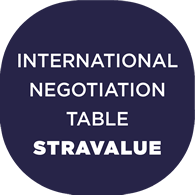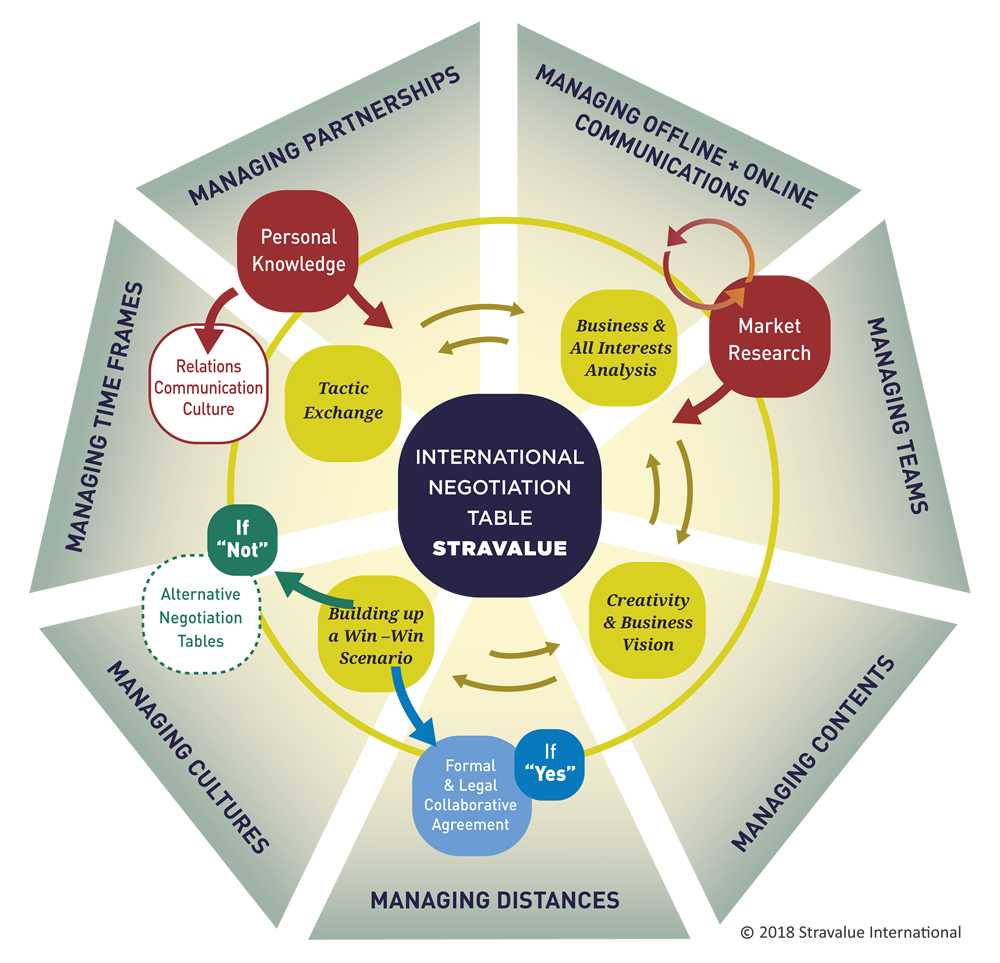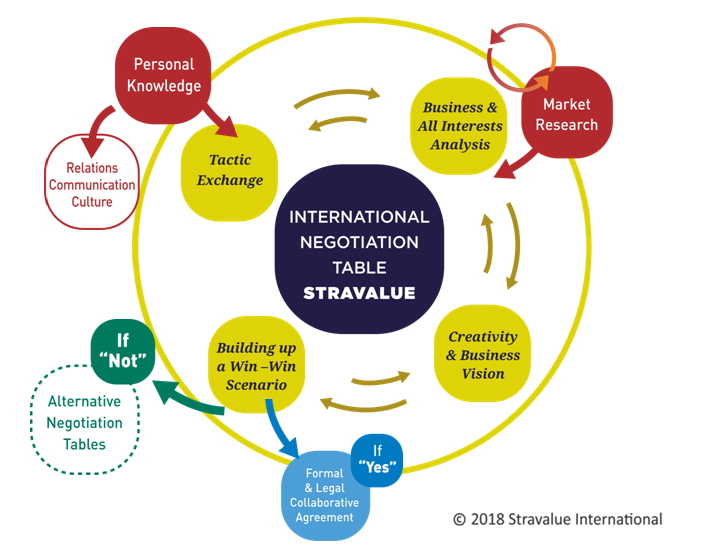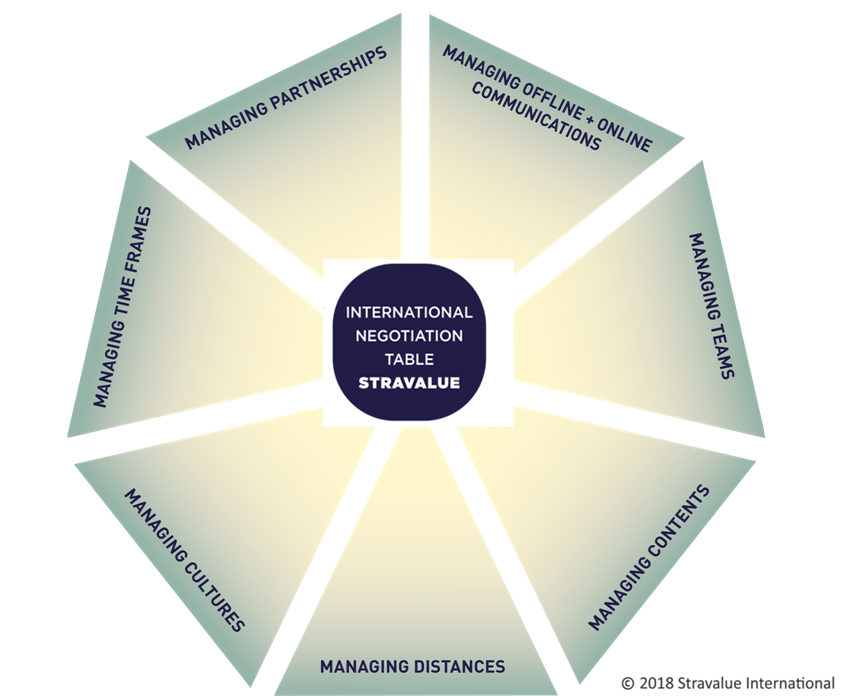
The Stravalue international negotiation table – creating and managing international business
Stravalue International is a team specialized in international business development through a methodology and set of competencies that aim to create value on a global scale for our clients.
Within our methodology to create value for our clients (in any national + international = global business scenarios), we have the pleasure of presenting our Stravalue international negotiation table.
The international negotiation table by Stravalue

1. Background and key ideas about the Stravalue international negotiation table
- A focus on collaborative versus competitive negotiations – a strategic approach that has its source in the Program on Negotiation – Harvard Law School
- Knowing how to negotiate internationally is or should be a key competency for all international business managers and professionals that wish to develop business globally
- As a consequence of the first two ideas, negotiating internationally is part of the Global Business Stravalue Playbook – a programme (itinerary), for developing business today and in 2020
2. Objectives of the international negotiation table:
From Stravalue´s perspective, the international negotiation table is base on:
- Negotiating means creating international business
- Knowing the market, the companies and the people involved in the negotiation
- Developing international business by creating value in a collaborative way
- Obtaining a stable, profitable and fair agreement, that generates international business value for all parties and in both domestic and international markets
3. The elements that form the negotiation table and areas of management
Stravalue´s international negotiation table is composed of different elements and areas of management, all of which from our experience are necessary in order to technically negotiate in complex and demanding international environment. By working all these elements and areas of management we can optimize and get closer to win-win agreements and therefore, create international business.
We differentiate between the elements that compose the negotiation table and the areas of management of the negotiation table.
3.1. The elements that form the international negotiation table

- KHOWING ALL THE PARTIES involved in the international negotiation before starting doing international business. From Stravalue´s experience in international business, it is necessary to dedicate the time to know with whom we will manage the negotiation table
- Establishing a previous RELATION based on COMMUNICATION (listening, listening…Online and Offline), while assuming that the CULTURE of the parties (understood as the interpretation of the reality), will influence both managing the negotiation table and optimizing international business opportunities
- MARKET RESEARCH: before entering the international negotiation table and once we´ve known all the parties and established a cross-cultural communication and relation, we will conduct a research in the market where we wish to create business and study: offer and demand, brand positioning, online and offline sales channels in our target market, pricing and value strategy
- Continuing with the analysis of the elements that compose the Stravalue international negotiation table and before entering the strategic business value to be created between the different parties present at the negotiation table, Stravalue suggests to develop a TACTICAL EXCHANGE in order to know the business interests of each part
- BUSINESS ANALYZE: the next element on our negotiation tables requires strategically answering these questions: Which is my business now? Which could be my business in the future? In any case, our business analyzes and outcomes should always be contrasted with the business that all parties on the negotiation table could generate in a collaborative manner. This business analyze is an element through which we pursue the balance between an international market research study and the business value that could result from the negotiation table.
- Within the different elements that combined form the international negotiation table, CREATIVITY and STRATEGIC BUSINESS ORIENTATION hold an important place and role. Yes, building international business value requires a permanent exercise where all parties should combine creativity and a business vision in order to create the best business scenario(s) for all parts involved in the negotiation table.
- Learning for our international negotiation experiences with our clients, we underline that the negotiation table will generate stable and profitable value when there is a win-win collaborative scenario. This means that win-win situations should dominate over win-lose situations.
- Stravalue´s international negotiation table means managing different ALTERNATIVE NEGOTIATION TABLES either simultaneously or sequentially. Our experiences taught us that we can´t successfully negotiate without having the knowledge, reference or experience in managing other alternative negotiation tables within the same business.
- And last, but not least, this itinerary of elements that compose the international negotiation table, when managed step by step and once it has created the necessary collaborative value for all parties, will end with a FORMAL AND LEGAL AGREEMENT that will create stable and profitable international business in our domestic and/or international target markets
3.2. Areas of management of the international negotiation table

1. Managing online / offline communications
In international negotiations, following Stravalue´s methodology, we have to manage the online communication step by step in order to prepare a successful offline agreement. So, online communication can be a driver when preparing the negotiation and when managing distances and timing while offline communication facilitates building relations, trust and closing a win-win negotiation.
2. Managing teams
A second area of management in the negotiation table is Human Resources (HR). Managing HR involves identifying the international negotiation profile of our own team and the other part´s team. It also entails optimizing our know-how in international negotiation and share this knowledge with the rest of the team. Furthermore, managing HR in international negotiation implies counting with multi-disciplinary, cross-cultural and technical teams (either internal or external teams) that are able to understand our and the other part´s business.
3. Managing contents
Continuing with the areas of management of the international negotiation table, in which regards managing contents, first of all we have to define the contents / interests of the parties involved in the negotiation while remaining open to add new contents during the course of the international negotiation.
The final agreement of the negotiation has to be a sum of small individual agreements obtained step by step, content by content. We should also quantify the success of the international negotiation based on the value generated by each content for each of the parts.
4. Managing distances
When negotiating internationally we should always take into account the distances between different international markets in terms of: geography, legal regulations, labor regulations, fiscal and economical regulations, safety, level of technological development, environment… These distances define the business environment where the international negotiation will take place. Being aware of these distances and exchanging knowledge between the parts involved allows us minimize the potential negative impact of these distances and optimize the potential positive impacts. Managing distance is a natural part of developing international business and we shouldn´t simply presume that these distances will cause a negative impact, but manage it through know-how and competences of the parts and their external advisors.
5. Managing cultures
Continuing with the areas of management of the international negotiation table and from our practical experiences in international business, when negotiating internationally we should always be aware of the different cultures (by culture we understand the interpretation of the reality that each part does), present at the negotiation table. Therefore, we have to manage the impact of the culture and different negotiation styles when creating international business value.
According to Jeswald W. Salacuse in his article Top Ten Ways Culture Can Affect Negotiations – these are the 10 cultural factors that affect the negotiation:
- Purpose of the negotiation (contract or relations)
- Attitude and objectives of the negotiation (win-win or win-lose)
- Personal styles (formal or informal)
- Communication styles (direct o indirect)
- Sensitivity to time (high or low)
- Emotions (high or low)
- Agreement format (personalized or general)
- Itinerary for reaching an agreement (from below upwards and from upwards below)
- Organization of the negotiation team (leadership or consensus )
- Risk taken (high or low)
6. Managing time frames
The next area of management requires managing time frames during the different steps of the international negotiation process. Dedicating time in order to prepare the international negotiation, prioritizing contents to negotiate or dedicating time to each content accordingly to its importance, are all part of managing time frames.
Following our Stravalue methodology, we recommend negotiating stage by stage and allow the necessary time to establish a good communication and relation with the parts. It is also key to prepare an agenda of contents and objectives for the international negotiations and to be prepared to manage timings and blockages that might result during the international negotiation.
Cultivating a long-term orientation when doing business internationally favors integrating the international interests of all the parts and thus, allows us to comply with the established timing. Finally, the formal draft of the international agreement should mark the last stage in the chronology of the negotiation process.
7. Managing Partnerships
When completing the management of the negotiation table with a focus on collaborative scenarios, the partnerships are formal instruments that allow us to look for complementary knowledge and synergies in order to generate international business.
Learning from our experience, in order to successfully manage partnerships, first of all we should identify the objectives of the international partnership (exchanging products, corporative learning, gaining market positioning, technical assistance…), and identify shared valued through the partnership.
Then, it is highly important for the partnership to generate more value that it would generate each part individually. Therefore, it is better for the parts to be complementary in competencies and actives (rather than similar), but in terms of management, the parts should be rather similar than different.
A formal written agreement should mark the closure of the partnership and then the agreement should be revised periodically.
To sum up, managing partnerships is a co-branding exercise that aims to create a superior brand value with regards to competitors and cultivate a market and client orientation.
4. The methodology of Stravalue´s international negotiation table
Based on our experience with clients in developing international business, practicing the negotiation table means:
- Regarding the elements that form the international negotiation table: identify, study and manage sequentially each element, without losing the flexibility treat each element accordingly to the dynamics of the negotiation process. The order in which we present the elements that form the negotiation table follow a logical sequence: for example we should first establish a communication and relation with the other part and after that start negotiating; or, first we should develop a market research study and then establish a win-win agreement.
- Regarding the areas of management of the international negotiation table: manage all of these areas dynamically and simultaneously. This is why all areas of management should be taken into consideration when creatively developing Stravalue´s international negotiation table. For instance, we will manage the teams from the beginning until the end of the negotiation, and after closing the agreement as well. In any case, a logical order of areas to be managed in order to optimize value is clockwise (following the image of the international negotiation table): starting by managing the online and offline communication and ending with managing partnerships.
Considering, that Stravalue´s international negotiation table is created based on our experiences and practical cases of value creation for our clients, we will continue to share and enrich our methodology with new experiences in international business development.


